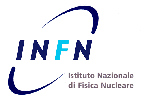Speaker
Dr
Fabio Colamaria
(BA)
Description
Heavy quarks (charm and beauty) are excellent probes to investigate the properties of the strongly interacting matter formed in heavy-ion collisions, where a Quark-Gluon Plasma (QGP) is produced. Due to their large mass, charm and beauty quarks are produced in hard partonic scattering processes in the initial stages of the collision, before the formation of the QGP. While traversing the medium they experience the full evolution of the QGP and interact with it.
ALICE measured a significant suppression of D-meson production in a wide momentum range in central Pb-Pb collisions with respect to the expectation based on the cross section measured in pp collisions, scaled by the number of binary collisions. This effect can be, at least partially, attributed to the energy loss of charm quarks while traversing the medium. The comparison of angular correlations between charmed mesons and charged hadrons produced in pp, p-Pb and Pb-Pb collisions can give insight into the mechanisms through which charm quarks lose energy and help to spot possible modifications of their hadronization induced by the presence of the medium. The analysis of pp and p-Pb data and the comparison with predictions from pQCD calculations, besides constituting the necessary baseline for the interpretation of Pb-Pb data, can provide relevant information on charm production and fragmentation processes. In addition, possible differences between the results from pp and p-Pb collisions can provide information on the presence of cold nuclear matter effects, affecting the charm production and hadronization in the latter collision system.
We will present a study of azimuthal correlations between D0, D+, and D*+ mesons and charged hadrons in pp collisions at √s = 7 TeV and p-Pb collisions at √sNN = 5.02 TeV. D mesons were reconstructed from their hadronic decays at central rapidity in the transverse momentum range 3 ≤ pT ≤ 16 GeV/c and were correlated to charged particles reconstructed in the pseudorapidity range |η|<0.8. Perspectives for the measurement in Pb-Pb collisions at √sNN = 2.76 TeV will also be presented.
Author
Dr
Fabio Colamaria
(BA)

